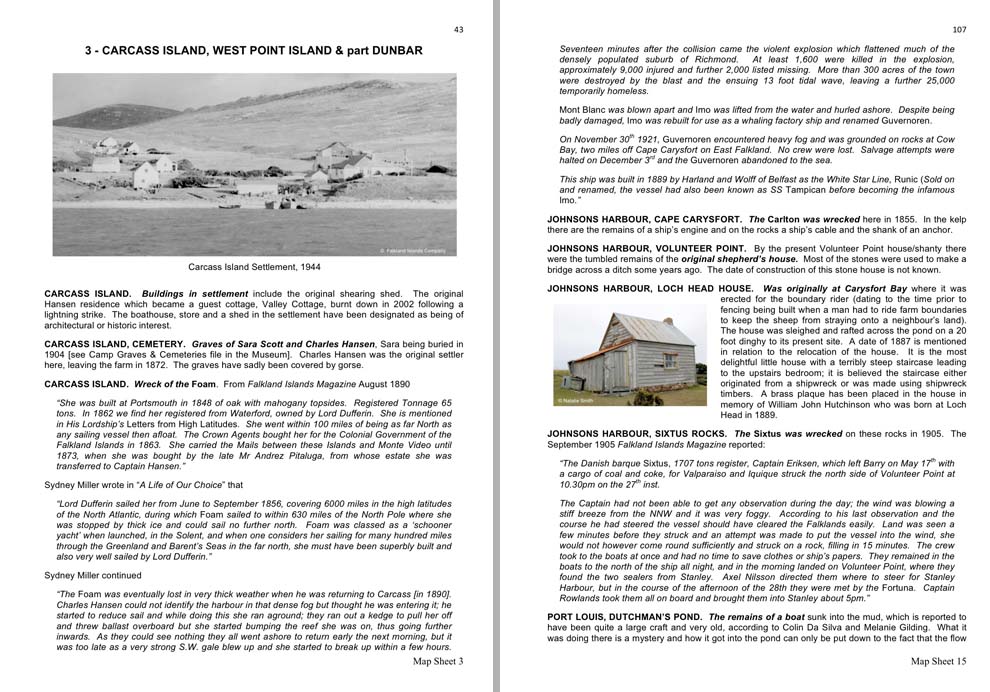

'Camp is the real Falklands' I was told when I first visited the Islands in the late 1980s. Certainly Camp, the rural landscape with the farms which covered all the mainland of the Islands, was unique. Vast tracts of land &endash; at least by English standards &endash; farmed by a race of hardy farmers, almost entirely self-sufficient, with occasional visits from the ships which delivered their supplies and took their wool to market in faraway Bradford.
Joan Spruce's book Falklands Rural Heritage fills the need for a guide to Camp, for a detailed account of each individual settlement, of its buildings, its families, particularly the characters who abounded there, their visitors and those accidental and unfortunate drop-ins who crawled ashore after their ships had been wrecked nearby. Joan herself is uniquely qualified to undertake this study. She has written on Falklands cooking, produced a short book on Corrals and Gauchos and she has collaborated with the late Jane Cameron and with Sally Blake in producing the Dictionary of Falkland Vocabulary.
Joan is particularly delighted to have been joined by Natalie Smith in producing this book. Natalie is dedicated to the Falklands and it is a pleasure to see a new name added to those recording the Falklands past.
This book is real folk history: certainly Joan has combed the records of Government and the Falkland Islands Company as well as many other written sources &endash; diaries and letters. But she has also spoken to the people who lived in the various settlements or who remembered the stories of their parents who were 'Campers'. Joan has visited all the settlements she describes and she has made it much easier for everyone who follows her to appreciate the history of these small groups of houses, jetties and corrals and relate to the people who once lived there and in many cases still live there. She brings Camp to life for our pleasure and education.
For about one hundred years wool exported from Camp supported the Falklands economy and produced a modest surplus for Government and indeed contributed to the balance of payments of the United Kingdom. Joan does not go into the changes to Camp since the Invasion of 1982. The large farms have been sub-divided and a new breed of individual farmers has taken their place. Their isolation has been eased by the Islander aircraft of the Government Air Service, by a modern telephone system with mobile coverage and by an unsurfaced road network, and cross-Sound ferry link, which makes it possible to drive to Stanley and other settlements and to send the wool clip out by tractor or lorry. In many cases the new owners may miss the companionship of the old settlements, but they have the satisfaction of taking their own decisions and enjoying the fruits of their own labour.
What is very clear from this book is the appeal which Camp still has to Islanders whatever their origins. Camp graveyards were refurbished by the Museum and National Trust; the young people who compete for the Alastair Cameron History Prize recount the lives of their ancestors from Camp and the detailed history of individual settlements. History is very much a living subject on the Islands and it is nourished by the Falkland Islands Museum and National Trust and by the Jane Cameron National Archives &endash; both of them excellent institutions.
Amateur historians Joan and Natalie have added a great deal to our knowledge of the Islands and with this book they put Islanders and everyone interested in the Falkland Islands greatly in their debt.
David Tatham
Editor of the Dictionary of Falklands Biography
Governor of the Falkland Islands 1992-1995
At this time, it is intended that once all costs have been recovered, any profits arising from the sale of copies of Falkland Rural Heritage are to be donated to charities, which may be operating and contributing to life in the Falkland Islands.



HOW TO ORDER:
The book, which is softbound, in full colour and contains 240 pages full of information, has a recommended retail price of £22.50 + packing and postage.
Available from: